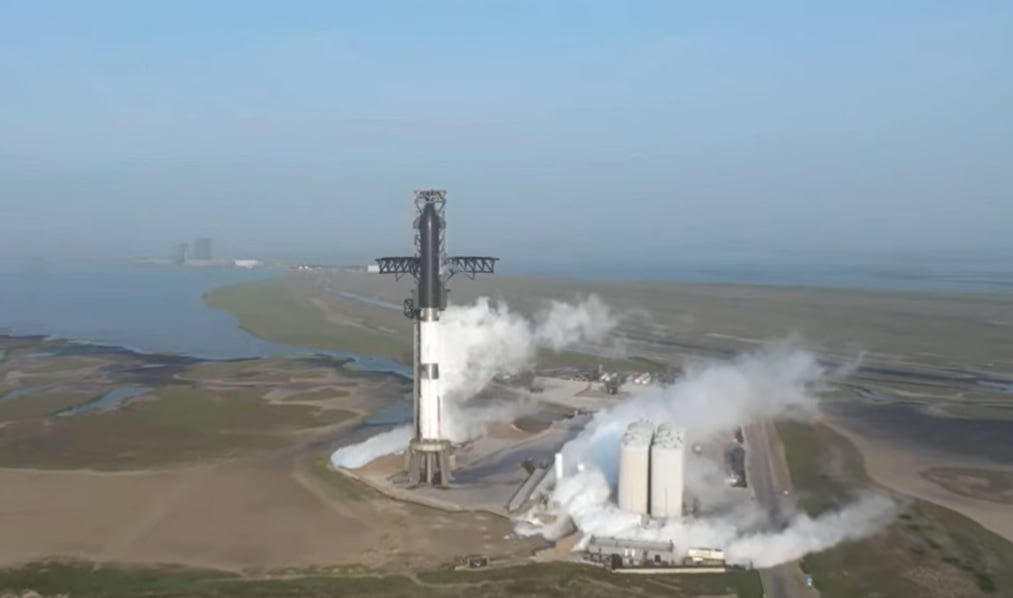 Elon Musk’s SpaceX Starship launched on Thursday but just four minutes into its flight, the rocket system failed and exploded. Credit: Video screenshot/Space X
Elon Musk’s SpaceX Starship launched on Thursday but just four minutes into its flight, the rocket system failed and exploded. Credit: Video screenshot/Space XElon Musk’s SpaceX launched on Thursday the inaugural test flight of Starship, the most powerful rocket ever created and the vehicle that could one day return astronauts to the moon or — perhaps — propel the first trip to Mars.
However, just four minutes into its flight, the rocket system failed to separate properly and exploded.
Nevertheless, SpaceX officials have lauded the mission as a success and were elated that the Starship and its huge booster rocket were able to make it into the sky.
Starship mission comes to an explosive end
The Starship test flight is now over, after experiencing what engineers have called a “rapid unscheduled disassembly” during ascent.
“To make it this far is amazing,” engineers say, after the rocket cleared its tower and successfully lifted off. “You never know what’s going to happen,” they say, adding that “Starship gave us an exciting end to an incredible test”.
SpaceX CEO Elon Musk congratulated the team on an “exciting test launch” despite the mission’s explosive conclusion.
Congrats @SpaceX team on an exciting test launch of Starship!
Learned a lot for next test launch in a few months. pic.twitter.com/gswdFut1dK
— Elon Musk (@elonmusk) April 20, 2023
Musk had previously urged people to maintain realistic expectations ahead of the launch and said that the Starship only had a 50% chance of reaching orbit on the first launch.
The SpaceX Starship did in fact make it up to 39km into the atmosphere. It was at this point the upper stage failed to separate as planned from the Super Heavy booster and the explosion ensued.
Crucially, the Super Heavy booster and the rest of the spacecraft passed a point called max Q, where forces on the spacecraft reach their highest point before entry into the less dense upper atmosphere.
This is why SpaceX engineers were still elated rather than dejected when the Starship exploded. The ability of the Super Heavy booster to reach this point on its first flight was a major milestone and provided validation for the spacecraft’s design.
Given the scale of the spacecraft and its power, a successful launch alone was enough to make history. Starship is almost 120m (400ft) tall and has a thrust power that is almost double that of any other rocket ever built.
With further test missions scheduled in the following months, the spacecraft manufacturer’s CEO is confident that future attempts have an 80% chance of success.
Elon Musk’s SpaceX constructed the world’s tallest rocket launch
To date, the SpaceX team has completed multiple sub-orbital flight tests of Starship’s upper stage from Starbase, successfully demonstrating an unprecedented approach to controlled flight.
These flight tests helped validate the vehicle’s design, proving Starship can fly through the subsonic phase of entry before re-lighting its engines and flipping itself to a vertical configuration for landing.
In addition to the testing of Starship’s upper stage, the team has conducted numerous tests of the Super Heavy rocket, which include the increasingly complex static fires that led to a full-duration 31 Raptor engine test – the largest number of simultaneous rocket engine ignitions in history.
The team has also constructed the world’s tallest rocket launch and catch tower. At 146 meters, or nearly 500 feet tall, the launch and catch tower is designed to support vehicle integration, launch, and catch of the Super Heavy rocket booster.
Future plans
SpaceX plans to eventually make both the booster and the ship reusable, allowing them to be refueled and relaunched. The company has been testing different methods of constructing steel vehicles at Boca Chica, where several models are waiting for their turn to take off.
NASA is one of the most interested parties in the project and has given SpaceX nearly $3bn to develop a version of Starship that can transport astronauts to the Moon.
Development of Starship has been based at the SpaceX Texas spaceport, about 40 minutes outside Brownsville, on the US-Mexico border.
Testing began years ago with brief “hop tests” of early spacecraft prototypes. The company started with short flights that lifted a few dozen feet off the ground before progressing to high-altitude flights, most of which resulted in dramatic explosions as the company attempted to land the prototypes upright.

 1 year ago
117
1 year ago
117











 English (US)
English (US)